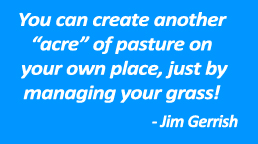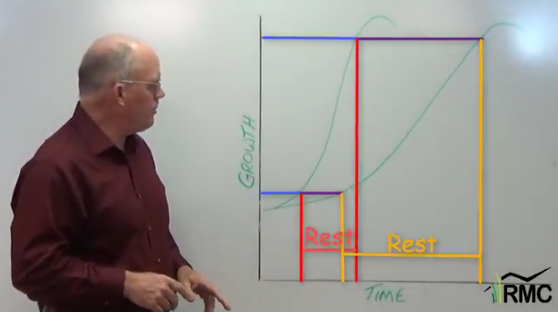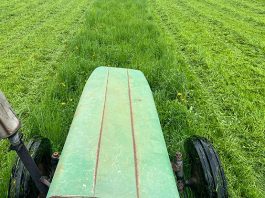This piece is drawn from a presentation Jim Gerrish did in 2015 sponsored by the Iowa Beef Center. We’ve embedded the 15:20 video of the presentation where Jim talks about the benefits of “wasting grass.” We’re also summarizing it in two bite size articles to make it easier for all you farmers and ranchers on the go and those of you with slow internet connections.
Research Jim Gerrish has done, along with his years of experience, shows that when we graze grass down to about 2 inches, it takes significantly longer for that grass to recover than it would have if we’d moved the cows out when the grass was still 4 to 6 inches tall. What he’s looking for is what he calls “Phase 2” residual – grass that has been grazed to between 4 and 6 to 8 inches.

When grass is grazed like what you see in this picture, it takes about 40 days to grow one ton per acre.
Wasting Grass Builds Better Pastures
Making the decision to “waste grass” can be difficult, as Jim describes in this scenario:
“We’ve gone out to the pasture. We went out thinking, ‘Oh, I’m going to move the cows today.’ But you look at this and you see all this green grass left behind, and you’ve got the question. Do I leave them there and not waste grass? Or do I move them?”

“Ten years ago, everybody would have said, ‘That’s wasting grass.’ And they’d want to stay there and use it because in this country we have a great fear of wasting grass,” says Jim. But if we want to take the step toward better soils, and more productive pastures and livestock, Jim says we need to understand these three things:
1. Grass feeds grass
2. Grass feeds soil; and last
3. Grass feeds livestock.
 “If your approach to feeding livestock is “Gotta feed the cows! Gotta feed the cows!” you just used the grass up feeding cows,” Jim says. “If you leave grass behind, you leave the soil protected, it’s cooler, water’s not evaporating out of it, the plants have a chance to grow back, you can build Organic Matter. As you build Organic matter in the soil, you build infiltration capacity, water storage capacity and you can weather the drought far better than the person who has grazed it short.”
“If your approach to feeding livestock is “Gotta feed the cows! Gotta feed the cows!” you just used the grass up feeding cows,” Jim says. “If you leave grass behind, you leave the soil protected, it’s cooler, water’s not evaporating out of it, the plants have a chance to grow back, you can build Organic Matter. As you build Organic matter in the soil, you build infiltration capacity, water storage capacity and you can weather the drought far better than the person who has grazed it short.”
He continues, “If you leave grass behind, you leave the soil protected. It’s cooler, water’s not evaporating out of it. The plants have a chance to grow back. You can build Organic Matter….As you build organic matter in the soil, you build infiltration capacity, water storage capacity, and you can weather the drought far better than the person who has grazed it short.”
Wasting Grass Increases Productivity
If you graze your grass down to 1-3 inches, so it looks like the picture below, there will be a lot less leaf area, and more sunshine will be hitting the ground. Grazed to this degree, it will take about 64 days of recovery to grown one ton of forage.

 If you have a 200 day growing season and it takes you 64 days to grow 1 ton, you can grow 3 tons of feed. But, says Jim, “If you can grow a ton of feed in 40 days because you’ve left a better solar panel, you’ll return 5 cycles and grow 5 tons of feed. That’s a 60% increase in production from making the decision to leave more grass out there. We would waste grass and we got 60% more.”
If you have a 200 day growing season and it takes you 64 days to grow 1 ton, you can grow 3 tons of feed. But, says Jim, “If you can grow a ton of feed in 40 days because you’ve left a better solar panel, you’ll return 5 cycles and grow 5 tons of feed. That’s a 60% increase in production from making the decision to leave more grass out there. We would waste grass and we got 60% more.”

Wasting Grass Increases Profitability
If you need to increase forage, so you can increase the amount of money you make by selling beef, you could buy more land – at the going rate of $2,000 to $4,000 an acre – and graze the way you are now. Or you could change the way you graze. Yes, you’ll have to invest in stock water development, some fencing to do that, and you’ll have to move cattle on a regular basis, but Jim compares the cost of that to the cost of purchasing land.
 “What’s a reasonable dollar amount for taking 800 acres and putting good quality water and subdivision fences? $100 to $150 an acre. At $200 an acre that’s less than 10% of buying an acre of land. You can increase productivity by 60% – even double it in some cases. That’s what investing in the infrastructure to more effectively manage your own land can do. You don’t have to go out and pay $2,000, $3,000, $4,000 to get another acre of pasture. You can create another acre of pasture on your own place just by managing it!”
“What’s a reasonable dollar amount for taking 800 acres and putting good quality water and subdivision fences? $100 to $150 an acre. At $200 an acre that’s less than 10% of buying an acre of land. You can increase productivity by 60% – even double it in some cases. That’s what investing in the infrastructure to more effectively manage your own land can do. You don’t have to go out and pay $2,000, $3,000, $4,000 to get another acre of pasture. You can create another acre of pasture on your own place just by managing it!”
For the next “bite” in this series, click here. Jim will talk about two principles you must follow to make this work, and he’ll show you what the proper heights are for grazing different kinds of grasses.
Kudos to the Iowa Beef Center for doing a great job of sharing videos on its Youtube channel. You can learn even more by visiting their website.





I have noticed with my own livestock (mainly cattle) they will let me know when they feel like they are working too hard to feed their rumen. It is interesting to me that even our highly domestic livestock still remember the way things used to be when there were no fences, and they were left to manage themselves. When a wise steward pays close attention to their animals, and follows correct principles it is often that the correct time to move coincides. Grazers don’t want to ruin their source of survival any more than an adept Grazier does. Animals are smart but they can’t move fences properly.
I’m with Kent.
I am in north central Ohio and deal with the same issue. It doesn’t seem to matter how big of an area or how long I leave the herd there I always end up with clumps of 6-12″ K31 fescue and spots that are taken clear down to 1″ or less. I would be interested to know if anyone else has had this problem and been able to “fix” it? I am not working with a large herd (10 units or so) and I have often wondered if that is the issue?
And my cows won’t touch weeds like thistle until the grass is down a good bit. How do you get your cows to eat everything at once to 6 inches? My pasture has a lot of variety, and favorite plants are eaten first, typically to excess.
Milan,
I’ll agree it is much easier to accomplish appropriate grazing with larger herds than with a small group like you have. A big part of the difference is simply the space in which the herd operates.
When we were in MO we ran around 60-80 cow-calf pairs in the herd and we had good success at getting uniform grazing on daily rotations. Less so on 3-4 day grazing periods. We commonly grazed between 40000-80000 lbs/acre stock density. That meant paddock size was 1 to 2.5 acres
In ID we are generally running 400-500+ pairs in the herd and graze at 50000-90000 lbs/acre stock density. Paddocks are commonly 5-8 acres.
If you have 10 pairs, the paddock is probably in the .1 to .25 acres if you are doing daily rotation.
Our 500 pairs on 6 acers can move as a herd, expanding and contracting the herd density as they move through the pasture. With a small herd, I think herd function completely breaks down and that is why it is so hard to accomplish excellent grazing results on a very small farm compared to ranch scale operations.
30 years ago I thought MiG was a strategy that would work equally well at any scale of operation. Over the years I have learned that it definitely favors larger operations.
Jim
I have been learning and applying Proper Stockmanship as formulated by Bud Williams for nearly three years. This spring my two herds of approximately 35 pairs each have started grazing more closely as a herd and they seem to be taking one bite and moving on in large pastures and utilizing more of the area and started including brush and blackberry and some weeds in their diet. I still have tall clumps of certain species where the sward is mixed but on more uniform swards it looks like a lawnmower has gone over it with a 4-6″ stubble height. They continue this behavior even when occasionally confined to Bermuda grass paddocks as small as 4 acres.
I am currently working with a 12 pair herd for another owner that has started to behave in a similar manner on 20 acre pastures.
I think the trick is to get them to behave as a herd using Proper Stockmanship and they will start grazing better.
My cows don’t start politety eating at the end of the leaf and slowly eat it down – they grab a clump with their tongue and pull it all off at once. There’s never a 3″ residual – only a rough and uneven patchwork.
Hi Kent,
I would ask how long are your grazing periods?
In productive environments, we move stock daily. Our expectation is for the cattle to take a single bite from a plant and then move on.
We are not looking for a residual that looks like it was mown. If you end up with a very uniform residual starting from an irregular height pasture, individual animal performance will be suffering.
Because we work primarily with diverse pasture mixtures, the sward surface at the beginning of the grazing period is irregular in height, we expect the residual to be irregular as well. It might vary from 3-7″.
We don’t want the lowest grazed plants to be shorter than 3-5″.
Adjust the stock density to create the residual desired.
Perennial ryegrass and bluegrass swards will end up being shorter.
Jim Gerrish
Love the idea but I have sheep which like much shorter grass. Also, I am very envious of your land prices. Where I live in Wales in UK the cost is $11,000 to $15,000 an acre! Enjoy what you have!
Hi Ray,
The residual concept is really more about solar energy capture than height, per se.
Leaving the pasture when it still has enough leaf cover to intercept at least 40-50% of incident solar radiation is the appropriate residual. In the case of your much shorter sheep pastures, maintaining ground cover is the key.
I have been in much of the UK, NZ, & Ireland and I have seen way too many pastures grazed down too short to maintain adequate solar interception. In my view, the notion that sheep ‘require’ much shorter pastures is an excuse, not a reason for overly severe grazing.
Regarding land prices, there are plenty of places in the US where land prices are $10,000/acre and much, much higher, but there are also many places where they are lower.
The $3000-$4000/acre price for irrigated land in our valley is because we are 60 km from the nearest town, there is no actual town in our valley which is 150 km long, and there is not a paved road that runs all the way through the valley. Move to the next valley over the mountain range where there is a town and paved roads, the price for the same type of land will be $8000-$12000/acre.
Jim Gerrish
Comments are closed.